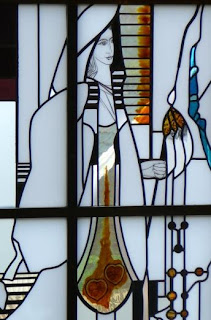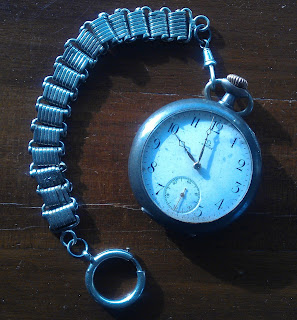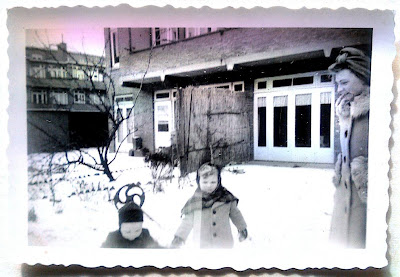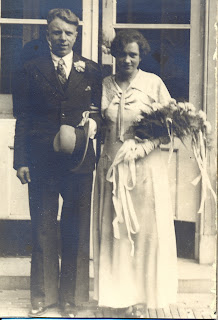 |
| Suriname |
 |
| 1. Please click to enlarge |
The transcription reads as follows:
13 April [1760]
Is opentlijk in de Kerk gedoopt een Americaansche Moor, zijnde een Lijfeigene
Van Den Wel Ed. Heer Sigismundis Pallak, oud Raad van Politie, Criminee
le mitsgaders Civile Justitie der Colonie van Surinaame, rivieren en Districten
van dien, welke Moor bij den H. Doop genaamt is: Christiaan. De getuijge
was De Wel Ed. Heer Sigismundis Pallak doch wegens absentie in Deszelfs
plaats: Johan Theobald Feilken en Johan Philip Kaping.
April {Coenraad Warms Hendrik Coenraad. {Hendrik Brand.
13 { Pieternel Wassenburg
And the English translation is:
April 13 [1760]
An American Moor has been publicly baptized in the Church, he being a slave
owned by the Noble Lord Sigismundis Pallak, former Councillor of Police, Crimi-
nal and Civil Justice of the Colony of Surinam, rivers and Districts
belonging thereto, during the Holy Baptism said Moor has been named: Christiaan. The witness
was the Noble Lord Sigismundis Pallak however due to absence in His
Place: Johan Theobald Feilken and Johan Philip Kaping.
April {Coenraad Warms Hendrik Coenraad. {Hendrik Brand.
13 { Pieternel Wassenburg
 In the deed the slave Christiaan is identified as a Moor. This term may need a little explanation. Today Moors are generally regarded as the islamic population of medieval Spain. Their origin was in Northern Africa. However, it is likely that Europeans in the 18th century and earlier used that name also for West Africans from Mali and Niger. Knowing that Christiaan got here in the entourage of a white European from Suriname, we can safely presume he was a black man with African roots. Suriname in those days was a well known destination for black slaves from Africa. Both the English and the Dutch played an important role in the slave trade. However, also the adjective 'American' was used. That is a bit puzzling. I am not sure what the term meant in those days. Did it refer to the present USA or maybe to any other country on the American continent? I don't know. In any case it suggests that his origin was outside Suriname.
In the deed the slave Christiaan is identified as a Moor. This term may need a little explanation. Today Moors are generally regarded as the islamic population of medieval Spain. Their origin was in Northern Africa. However, it is likely that Europeans in the 18th century and earlier used that name also for West Africans from Mali and Niger. Knowing that Christiaan got here in the entourage of a white European from Suriname, we can safely presume he was a black man with African roots. Suriname in those days was a well known destination for black slaves from Africa. Both the English and the Dutch played an important role in the slave trade. However, also the adjective 'American' was used. That is a bit puzzling. I am not sure what the term meant in those days. Did it refer to the present USA or maybe to any other country on the American continent? I don't know. In any case it suggests that his origin was outside Suriname.
Mr. Pallak, who was of German descent, lived in Suriname between 1744 and 1758. Apart from being part of government institutions there, he also owned several plantations. One of them was Maasstroom. That estate was close to Lust tot Rust (Want for Calmness) owned by Wigbold Crommelin, at one time the colony's Governor General. I mention this plantation's name because Christiaan came to live in Mr. Pallak's country seat in Zoeterwoude near Leiden. And that villa was also named Lust tot Rust which may be an indication of the nature of their relationship. You see both plantations mentioned on the map above in the blue frame.
 |
| 2. The deed of death of Christiaan Catiou, Jan. 11, 1816 |
With Christiaan now being a member of the Lutheran Church it is plausible that his death has been recorded in a Lutheran church register as well. Sofar I have been unable to uncover that, if it exists to begin with! However, after 1812 the church registers ceased to exist in favor of local government record keeping. And there I found the registration of the death of one Christiaan Catiou. Could he be the slave Christiaan? Well, all I can say is that it is possible but that is about all. There are some pro's and some con's for this hypothesis.
To start with the cons:
The surname Catiou already existed in Leiden during the 17th century;
The surname Catiou could very well be a French (Huguenot) name;
Many Huguenots lived in Leiden;
There is not a single direct link with Sigimundus Pallak.
But there are some pro's too:
When Christaan dies on Jan. 11, 1816, he is 73 years old. That puts his age during his baptism at approx 17 years old, not an impossible age for a slave to accompany his master;
He died in Zoeterwoude, the village where Pallak's villa was located;
In the deed it says that he lived at the address 235 Hooge Rhijndijk. The villa Lust tot Rust was situated at or near that location;
The surname Catiou is not a Dutch surname; could there be a connection with French Guyana, the country adjacent to Suriname?
I leave the conclusion up to you but whether the two Christiaans are one and the same person is uncertain at best. A further investigation Holland's largest database of historic newspapers did not result in anything useful. And that is a pity because the black Christiaan must have drawn a lot of attention in those days, both in Leiden/Zoeterwoude and in the Lutheran Church. But no matter what, my aim was to pay some attention to an extraordinary deed in the Leiden Archives.
*The Dutch effectively obtained Suriname from the English when they swapped it for New Amsterdam/New York during the Breda Peace Treaty negotiations in 1667...
**Leiden was also the city where the Pilgrim Fathers resided during the 1609-1620 period.
***Click on <Inzien register> [ image 286
Nederlandse samenvatting
Van hot naar her springend in Wikipedia, liep ik tegen een hoofdstuk aan over een koffieplantage in het Suriname van de 18e eeuw. Daarin was sprake van een slaaf genaamd Christiaan die met zijn meester Mattheus Sigismundis Pallak naar Leiden kwam om daar gedoopt te worden. Ergens anders had ik gelezen dat de heer Pallak het Lutherse geloof aanhing. Ik vroeg mij af of die doop nog in het Regionaal Archief Leiden was terug te vinden. En dat bleek inderdaad het geval, zie afb. 1. De doop heeft plaatsgevonden op 13-4-1760 in de Lutherse Kerk aldaar. De tekst van de doopakte staat onder de afbeelding.
In de akte wordt genoemd dat Christiaan een "Amerikaansche Moor" is, een wat raadselachtige term. Immers, Moren waren Noord-Afrikaanse Arabieren die in de middeleeuwen Spanje bezetten. Daarnaast was het in de 18e eeuw niet ongebruikelijk om inwoners van Mali en Niger met de term "Moren" aan te duiden. Dus het is zeer wel mogelijk dat we het hier over een slaaf hebben, in de doopakte staat "lijfeigene", van Afrikaanse afkomst. De vraag blijft dan waar het "Amerikaansche" betrekking op heeft. Is hij elders op het Amerikaanse continent geweest voordat hij naar Suriname kwam? Of was het een bestaande uitdrukking waarmee elke neger werd aangeduid?
De van Duitse afkomst zijnde Sigismundis Pallak was, naast overheidsfunctionaris, ook plantage-eigenaar, o.a. van de plantage Maasstroom. Niet ver daar vandaan (zie het kaartje waarin beide plantages blauw omkaderd zijn) lag de plantage Lust tot Rust van Wigbold Crommelin, op zeker moment Gouverneur-Generaal van Suriname. Waarschijnlijk niet geheel toevallig had Pallak's buitenplaats in Zoeterwoude de zelfde naam.
Omdat Christiaan dooplid van de Lutherse Kerk was geworden, vroeg ik mij of ook zijn overlijden te vinden zou zijn. Maar die akte heb ik in de DTB-registers niet kunnen vinden, als die akte überhaupt al bestaat. Voor de zekerheid heb ik ook gekeken in de vanaf 1812 ingevoerde Burgerlijke Stand. En daar kwam ik een akte van overlijden tegen van ene Christiaan Catiou, iemand met een niet erg Nederlandse achternaam (zie afb. 2). Zou hij "mijn" Christiaan kunnen zijn? Dat zou kunnen, maar meer is er niet van te zeggen. Er zijn argumenten vóór en tegen te vinden.
Tegen pleit:
De naam 'Catiou' bestond al in het 17e eeuwse Leiden;
Het zou best een Franse (hugenoten) naam kunnen zijn en er woonden vele hugenoten in Leiden;
Ik heb geen directe connectie met zijn eigenaar gevonden.
De voors zijn:
Wanneer Christiaan overlijdt op 11-1-1816 op 73-jarige leeftijd. Ten tijde van zijn doop was hij dus ca. 17 jaar, geen vreemde leeftijd om Pallak te vergezellen op zijn reis hier naar toe;
Hij is overleden in Zoeterwoude, de plaats waar ook het buiten van Pallak stond;
In de overlijdensakte staat dat Christaan woonde op het adres Hooge Rhijndijk 235. Op of in de nabijheid van dat adres stond ook het buitenhuis Lust tot Rust;
"Catiou" is een Frans aandoende achternaam, Zou er een connectie met Frans Guyana kunnen zijn?
Afijn, of het hier één en dezelfde persoon betreft, blijft duister. Ook een onderzoekje in kranten uit die tijd, heeft niets opgeleverd. Jammer, want de zwarte Christiaan moet toch in die tijd een bijzonderheid zijn geweest, zowel in Leiden/Zoeterwoude als in de Lutherse Kerk. Hoe dan ook, mijn bedoeling was om wat aandacht te schenken aan een toch wel bijzondere doopakte in het Leidens regionaal archief.
Image credits:
Plantation map: Het geheugen van Nederland
#1: Regionaal Archief Leiden, Doop-, trouw- en begraafboeken Leiden, 1575-1811 (1859), nummer toegang 1004, inventarisnummer 1004, afb. 286;
#2: Regionaal Archief Leiden, Gemeentebestuur van Zoeterwoude, nummer toegang 500B, inventarisnummer 1058, afb. 91.






















